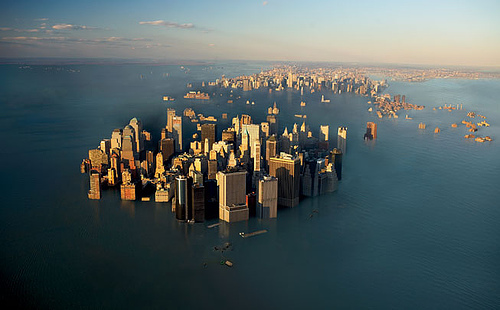Global warming and sea level rise

What is most concerning, scientists say, is that amount of melting was caused by an increase of only 1-2 degrees (Celsius) in global mean temperatures.
“Studies have shown that both the Greenland and Antarctic ice sheets contributed significantly to this sea level rise above modern levels,” said Anders Carlson, an Oregon State University glacial geologist and paleoclimatologist, and co-author on the study. “Modern atmospheric carbon dioxide levels are today equivalent to those about three million years ago, when sea level was at least six meters higher because the ice sheets were greatly reduced.
“It takes time for the warming to whittle down the ice sheets,” added Carlson, who is in OSU’s College of Earth, Ocean and Atmospheric Sciences, “but it doesn’t take forever. There is evidence that we are likely seeing that transformation begin to take place now.”
Co-author Peter Clark, an OSU paleoclimatologist, said that because current carbon dioxide, or CO2, levels are as high as they were 3 million years ago, “we are already committed to a certain amount of sea level rise.”
“The ominous aspect to this is that CO2 levels are continuing to rise, so we are entering uncharted territory,” Clark said. “What is not as certain is the time frame, which is less well-constrained. We could be talking many centuries to a few millennia to see the full impact of melting ice sheets.”
The review, which was led by Andrea Dutton of the University of Florida, summarized more than 30 years of research on past changes in ice sheets and sea level. It shows that changes in Earth’s climate and sea level are closely linked, with only small amounts of warming needed to have a significant effect on seal levels. Those impacts can be significant.
Six meters (or about 20 feet) of sea level rise does not sound like a lot. However, coastal cities worldwide have experienced enormous growth in population and infrastructure over the past couple of centuries – and a global mean sea level rise of 10 to 20 feet could be catastrophic to the hundreds of millions of people living in these coastal zones.
Much of the state of Florida, for example, has an elevation of 50 feet or less, and the city of Miami has an average elevation of six feet. Parts of New Orleans and other areas of Louisiana were overcome by Hurricane Katrina – by a surging Gulf of Mexico that could be 10 to 20 feet higher in the future. Dhaka in Bangladesh is one of the world’s 10 most populous cities with 14.4 million inhabitants, all living in low-lying areas. Tokyo and Singapore also have been singled out as extremely vulnerable to sea level rise.
“The influence of rising oceans is even greater than the overall amount of sea level rise because of storm surge, erosion and inundation,” said Carlson, who studies the interaction of ice sheets, oceans and the climate system on centennial time scales. “The impact could be enormous.”
The Science review is part of the larger Past Global Changes, or PAGES, international science team. A working group known as PALSEA2 (Paleo constraints on sea level rise) used past records of local change in sea level and converted them to a global mean sea level by predicting how the surface of the Earth deforms due to changes in ice-ocean loading of the crust, along with changes in gravitational attraction on the ocean surface.
Independently, Greenland and Antarctic ice sheet volumes were estimated by observations from adjacent ocean sediment records and by ice sheet models.
“The two approaches are independent of one another, giving us high confidence in the estimates of past changes in sea level,” Carlson said. The past climates that forced these changes in ice volume and sea level were reconstructed mainly from temperature-sensitive measurements in ocean cores from around the globe, and from ice cores.
The National Science Foundation supported the research.
About the OSU College of Earth, Ocean, and Atmospheric Sciences: CEOAS is internationally recognized for its faculty, research and facilities, including state-of-the-art computing infrastructure to support real-time ocean/atmosphere observation and prediction. The college is a leader in the study of the Earth as an integrated system, providing scientific understanding to address complex environmental challenges
Sea level is rising for the first time in thousands of years. Oceanographer John Englander, author of “High Tide On Main Street” and former GLOBE Series Speaker explains why it is unstoppable, regardless of efforts to be ‘green’ and sustainable. Using powerful images, he encourages us to embrace the new reality that the shoreline is moving, that we begin to adapt, while we also try to slow the warming. It is a positive message, “a glass half full, rather than half.



